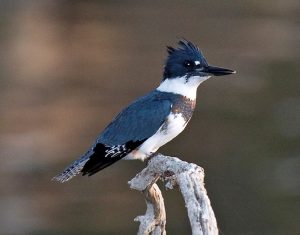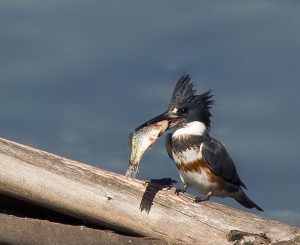
The Belted Kingfisher appeared in a recent journey-meditation to tell me…what exactly?
This colorful bird will be leaving my locale soon as ponds and lakes freeze over, though in much of the United States the Kingfisher overwinters. Various types of kingfishers live around the world, wherever there is open water, with the most colorful species in the tropics (of course).
Even in northern latitudes, kingfishers are relatively bright. The Belted Kingfisher is a lovely rich blue. This is a high profile bird, soring over ponds and divebombing for small fish. Sometimes she skims the water, her blue coloring blending in. The female in my area is blue to blue-gray, like the male, but with a rusty “belt” on her breast.
Kingfishers nest in mud burrows along the banks of rivers and ponds, tunneling on an upward slope three to six feet to lay their eggs. They form new nesting pairs every year. Males court females by bringing them fish.
The sound of a Belted Kingfisher is an unmistakable series of rattles that each last a full second or more. She makes this noise flying or when perched looking for prey. She is quite territorial and aggressive toward intruders.
I associate the Belted Kingfisher with the astrological Eighth House, that time of day when the afternoon sun has commenced a noticeable decline in the west. The Eighth House rules death, psychic activity, the occult, and other things that are hidden. Think of the Kingfisher diving into the still water for her meal. Think of the Kingfisher laying her eggs not in the trees or on the ground but in a cavity beneath the soft earth.

